When the sun rises in Menemsha it comes up over a swordfish.
Just before five a.m. on a cool July morning, low clouds in the east are thick with lavender hues and a red-pink glow growing stronger behind beach grass and dunes. The glow silhouettes the curving steel Jay Lagemann sculpture, commissioned for the Chilmark Tricentennial in 1994, of a man, his harpoon and his catch.
The parking lot at the end of Basin Road, filled to capacity just nine hours earlier as crowds on the beach clapped for the brilliant setting sun, is nearly empty. A seagull drags a clam around the lot, scraping the shell on the asphalt. In the west, over the harbor and Aquinnah, a full moon lingers in the sky. A small boat with a green hull heads toward the harbor channel, headed out to sea.
A 1944 story in the New Bedford Standard Times described Menemsha as a “suburb of Chilmark,” a description that is accurate only as it relates to location. Weathered fishing shacks, stacks of lobster pots and piles of crushed blue mussels, quahaugs and oysters everywhere are a far cry from standard images of suburbia. The same story also noted that Menemsha had “one of the best harbors on Martha’s Vineyard,” and that remains true today.
Today Menemsha remains a mix of old and new, with Everett Poole’s chandlery, the Vineyard version of fast food at the Bite and the Galley, Jane Slater’s antique shop, Menemsha Market, the post office and Coast Guard station, to name a few. But the soul of the place is the ocean, and specifically what comes from it. What is Menemsha without fish? The Lagemann sculpture isn’t a man harpooning a whale.
Fishing has changed since shacks first sprouted in what was then called Creekville. Permits are expensive, paperwork is exhausting and catches are heavily regulated as the fishing stocks ebb and flow. Menemsha continues; its rhythms persist even though the instruments and the musicians are different.
Nowhere is that more evident than along Dutcher Dock, the long wooden pier set parallel to Basin Road. Part of the deal in being a business along Dutcher Dock is helping the fisheries thrive. Named in memory of summer resident Rodney Dutcher, the dock itself was part of a massive effort to rebuild Menemsha after the village was essentially washed away during a September hurricane in 1938. For all of its weathered shingles, the buildings are actually far younger than they appear. The most recent was built just this winter.
That is not the case with the Little Lady.
Forty-two feet long and made of white pine, fir and oak, she is the only wooden dragger left in the harbor, on the Island and in the state. Her mast is bright orange and the boards lining her deck are narrow and at any given moment covered with sprinklings of seaweed brought up from the depths along with the daily catch of fluke.
“This boat’s been towing this net for 86 years,” said Dennis Jason Jr., pulling seaweed clumps from a mass of cords as he hoisted the net off the deck. He leaves the harbor around 4 a.m. each morning, returning at lunchtime with the day’s catch. The fluke season’s been great so far this year, he said, although on this particular day he called the haul “horrible.”
“It’s just fishing in general,” Denny said. “You can’t predict anything — you just take it one day at a time.”
He was eight or nine or maybe younger when he started going out on the Little Lady with his father, Dennis Sr., who is now the Chilmark harbor master. There was never anything else Denny considered doing.
“I mean, I love fishing,” he said. “When it’s great, there’s nothing better.” After high school, his father showed him the ropes for two years before the boat — bought by Denny’s grandfather in the 1940s — was passed on to a third generation of fishermen.
“I kind of feel like you almost need to be born into it,” Denny said. “It’s really a throw of the dice, all on potential,“ he said, speaking of fishing. That kind of uncertainty isn’t for everybody. But Denny fishes for another reason, too — to keep the Little Lady working.
“Fishing keeps it going,” Denny said. He’ll fish from the boat as long as he can, he said, but knows that everything has a lifespan, even a stalwart dragger. He has another boat, too, for conching and says diversity is the key to making it as a commercial fisherman these days. In the off season, his limit for fluke will drop from 300 pounds per day to 50 pounds. The off season limit has gone down three times in his memory, he said. When he’s out on the water at the fluke spots, Denny’s fishing companions are often boats from Fairhaven, Provincetown and New Bedford. Their catch sometimes comes to Menemsha and other times goes to different harbors. Denny’s go to the same place every day. “We always buy from the Little Lady,” Scott Larsen said, skimming his fillet knife through a fish as he stood at the back prep table of Larsen’s Fish Market. Founded by Louis S. Larsen Sr., 45 years ago, the market is now owned by Louis’s daughter Betsy and managed by Betsy and her sister Kristine. Scott is Kristine’s second cousin. It was Betsy’s day off.
“So I have to be her,” Kristine said. And in the summer, she said, “Oh, my goodness, it’s busy.” It was barely 10:30 in the morning and every part of the market bustled, even though there weren’t customers yet. In the front room there was the display case to prepare. In the kitchen area, workers were parceling out to-go containers of seaweed salad, making chowder. In the back room it was fluke prep.
Yesterday the Little Lady brought in 70 pounds of fluke. The pile in the metal basin next to Scott grew larger; it took him no more than 15 seconds to finish up each fish. Earlier he’d gone to work on half of a 260-pound harpooned swordfish, not from Vineyard waters, but Atlantic nonetheless. Louis S. Larsen and his brothers were renowned for their skills at swordfishing in the heyday of the fishery.
Scott’s cousin, Matteus Scheffer, stood at the other station in the back room, weighing out bags of steamers. Where the Larsens are a fishing family, the Scheffers are shellfishermen; Matteus’s grandfather Roy provides the market with its oysters. His father Isaiah is the Chilmark shellfish constable.
It’s my 15th year here,” Scott said. He paused a slight beat. “I know! It’s hard to imagine — I’ve been here longer than Matteus is old. That’s so crazy to think about.”
Matteus is 14. The Larsen’s gig is his very first job, he said, and he does a little bit of everything each day. “I’m enjoying it so far,” Matteus said.
“He’s already shucking oysters,” Scott said. He rinsed off the large fluke pile, then looked out the window to the harbor, pointing out diving terns.
“We called ourselves dock rats,” Kristine said of growing up at the fish market. “My sister and I were reminiscing about that the other night. Our parents would put us all in pajamas and trek to Menemsha and we’d hang out on the dock. We’d get ice cream at the Galley or the gas station.”
The other night, there was an impromptu jam session on Dutcher near the Menemsha Texaco when Jemima James and friends turned up with their instruments.
“They just come up and start playing,” said Marshall Carroll, who with his wife Katie, owns and runs the Texaco at the end of Dutcher Dock. The station caters to both cars and boats; cars go to one of the four pumps outside, while boats tie up at the fuel dock that extends off the Dutcher terminus. Menemsha Texaco is a utilitarian, sturdy outpost of a place, open year round. In winter when the snowy gales blow in off the channel, there is always a pot of coffee on. In summer when the docks smell of clean fish and diesel fuel and boat people mingle with tourists and children clad in life jackets scamper about, it is a hub for ice, cold drinks and candy bars. And there is still always a pot of coffee on.
The gas station has been a Carroll endeavor since 1972, but like everything else in Menemsha, it has its roots in fishing. Emmett Carroll, Marshall’s father, was a fisherman, lobsterman and oysterman before buying the station. It was the site of Marshall’s first job. He met Katie on Menemsha Beach. Their daughter Bradley, who is heading off to college in the fall, now pumps gas in the summer. Her growth chart, along with that of every other teen who’s gotten a start at the Texaco, is etched on the wall behind the cash register.
Fuel is a sunk cost for fishermen, but the boats are able to tie up for free at Dutcher Dock when they come in to drop off catches. One of the main roles of harbor master Dennis Jason and his assistants is to keep the tantalizing open space free for working boats. The harbor master shack sits next to the Texaco and was built over the winter by vocational students at the regional high school. Its cedar shingles have not yet begun to weather.
The draggers start to return to the harbor around nine in the morning.
“It’s amazing how much comes in,” said Stanley Larsen, who runs his own fish market next door to his cousins Betsy and Kristine. “Fluke, flounder, lobster, shellfish . . . most of the fresh, local wild seafood comes in here, to Menemsha.”
A Vineyard-caught swordfish, landed with a rod and reel by Keith Lombardi, came in over the weekend. Though there are no boats wholly dedicated to the fish anymore, tuna fisherman sometimes catch swordfish while they’re out on their trips.
“It’s a really nice fish,” Stanley said, after two customers came in and filled up a cooler with ice and slabs of the rippling swordfish meat. “Everyone that’s had it says it’s really good, almost like getting harpooned sword.” It’s the second to come in this season, which seemed promising for the fishery, Stanley said.
The market space was first built in 1945, when Everett Poole opened the first fish market in Menemsha after the wreckage of the 1938 hurricane. Stanley bought the building, not the land which is owned by the town, in 2004. He worked for Louis S. Larsen growing up, and running a fish market was something he’d always wanted to do. When he’s not at his market, Stanley’s on the water in his dragger, bringing in his own fluke. At the beginning of the season, he goes out every day. But now that summer’s in full swing, the market demands more time.
On good days in season, when the fluke fishermen are all landing 300 pounds of fluke, there are few places that can manage the sheer volume of fish coming over the docks.
Outside the Menemsha Fish House, Vineyard Haven fisherman Mitchell Pachico attached plastic yellow tags to each of 10 large striped bass he’d landed in the morning. The fish were buried in a deep tub of ice; only four were visible. Two people stopped to take photos of the action.
“Every time you bring them in to sell, you have to put a tag on it just to keep it legal,” Mitchell explained.
Upstairs in the office of the fish house, where three chest freezers hummed and an air conditioning unit sat unused, Michael Holtham, local seafood coordinator (“It sounded better than general manager”) for the business, answered a call from Jacob Vanderhoop at the Aquinnah Shop.
“Jacob, what’s happening? We have oysters, yes. Today’s a good striper day.” On the other end of the line Jacob ordered 10 pounds of halibut and 20 of bass, along with the oysters. “Do you want me to throw it on the bike ferry?
“I look at myself as a broker for the fishermen — the ones that are out there working hard,” Michael said. The fish house was founded by Alec Gale and Tim Broderick, and added to the Dutcher lineup in 2011. It’s a wholesale operation, providing Island restaurants with fresh catches and shipping the excess up to Boston through a partnership with Red’s Best. Alec and Tim also grew up in Menemsha, and in many ways are emblematic of the new young generation of fishermen here.
The striped bass Mitchell Pachico caught were headed to the Harbor View Hotel. They’d called in earlier asking what was good, knowing that Michael, who grew up across the harbor working at the Home Port, long owned by his family until 2008, had the chops to pick out the best local catch.
“It’s a 24-hour job,” Michael said. On his day off, he came in anyway to work on coordinating orders, staying until the evening. But his job is nothing, he said, compared to what the fishermen themselves are doing. And the second-floor office has its perks.
Michael flicked the screen on his iPhone.
“We had an incredible sunset the other night,” he explained, searching for the right photo. “I had to get up on the roof.” He’d climbed up the outside refrigerator and around the side of the building, pulling himself up to get the best angle. “I had to try and capture it.”
He wasn’t the only one. When the sky began to turn pink that night — the first sign of the show — the beach was already packed. Some brought chairs, others set out towels. Everywhere, iPhones were held up and aimed westward. There were no clouds high in the sky, and the sun was a perfect blazing sphere. People sipped cups of chowder and slurped oysters.
At exactly 8:16, the blaze slipped beneath the horizon beyond the sea. The crowd clapped. A boat honked, and the parking lot began to empty. People walked up Basin Road, back to their cars, past a sculpture in the dunes of a man, his harpoon and his catch.


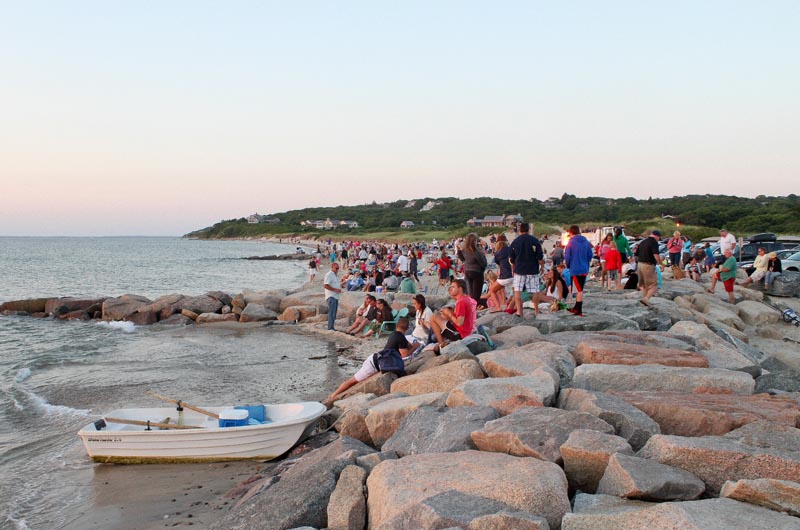
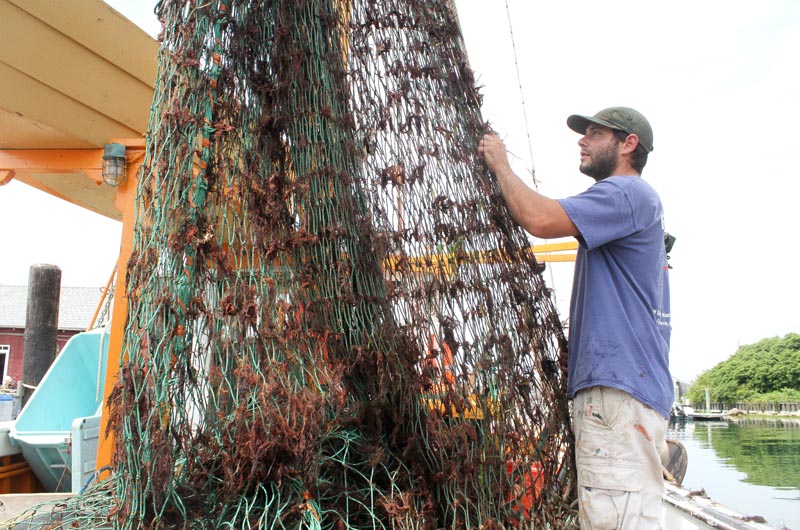
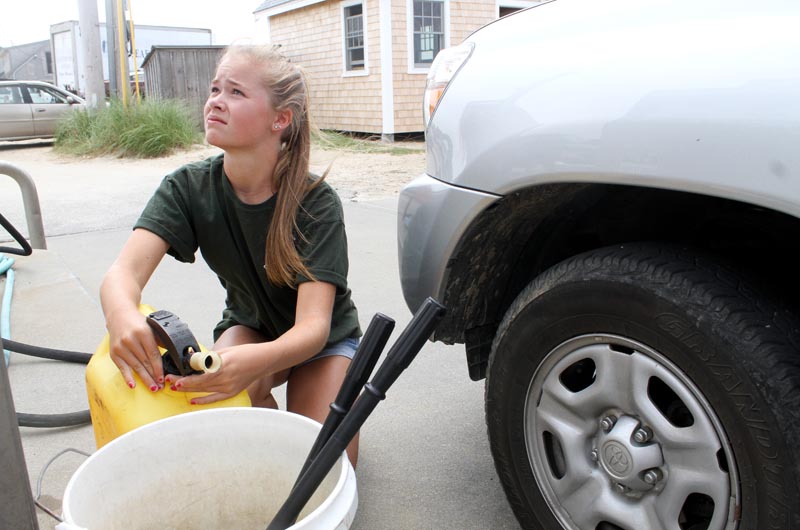

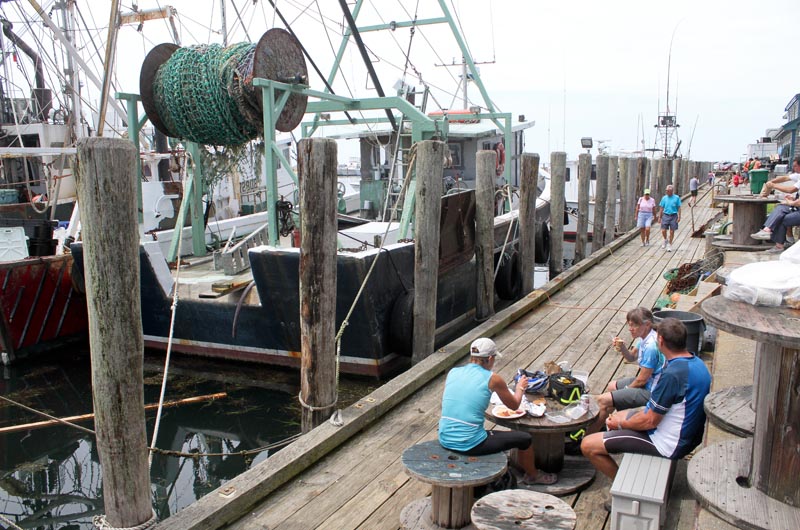
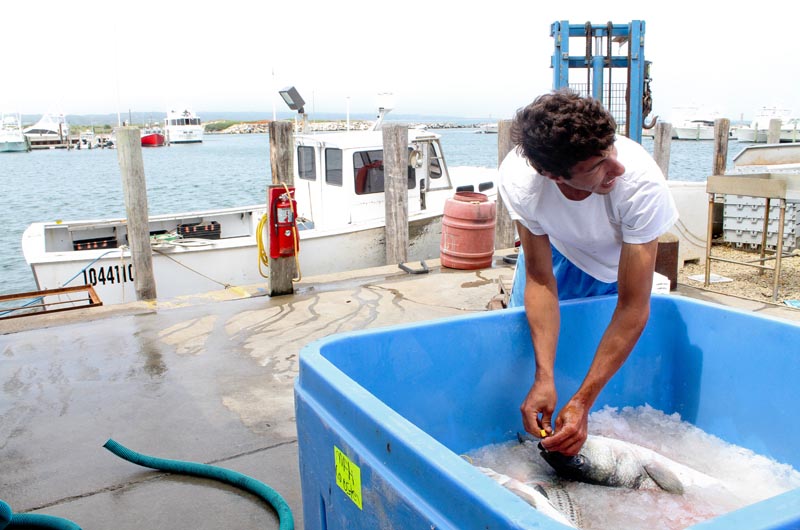





Comments (11)
Comments
Comment policy »